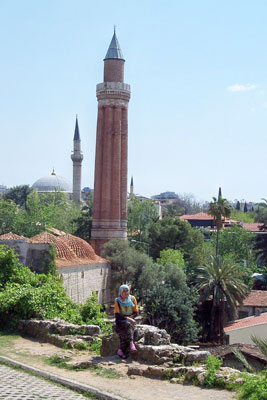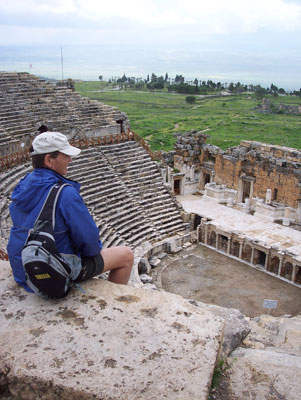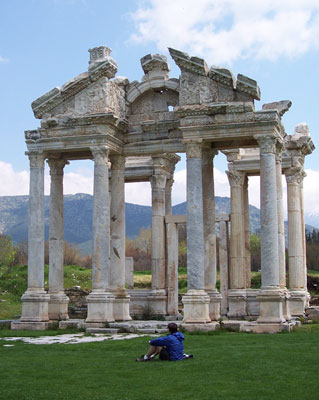Kuşadası to Antalya
by Randy Keck (Part 1 of 3 on Turkey)
A long-awaited opportunity to visit the much-heralded nation of Turkey finally materialized in April ’09. My exploration of the western half of that country was hosted by FLO-USA (Orlando, FL; 888/435-6872, www.flo-usa.com) and Turkish Airlines (800/874-8875, www.thy.com) and revealed a fascinating, overtly visitor-friendly destination offering limitless attractions.
I was traveling in a small group of three on a 14-day/12-night tour entitled “Best of Turkey” ($2,884-$3,087 per person, double occupancy, land only), which provided an excellent, balanced introduction for the first-time visitor.
Despite having done my normal pretrip research, I was astounded by the plethora of ancient ruins, whose combined histories form the base of our civilization today. Western Turkey, as a result, felt much less foreign than I had anticipated.
While Turkey is a country with a large Muslim majority, its philosophy of religious tolerance and the degree to which it embraces democratic political principles results in modern-day Turkey being a true East/West crossroads not only geographically but culturally and psychologically.
Ephesus
Our touring base for the first two nights was the small, scenic Aegean resort town of Kuşadası. We accommodated at the seafront Korumar Hotel, where we shared the facility with a large, European, professional cycle-touring group.
From Kuşadası we explored the incomparable ancient city and cultural center of Ephesus, which was founded in the fourth century by Lysinachus, successor to Alexander the Great. In its heyday it was the third-largest city in the Roman Empire. Our thorough tour of the extensive ruins provided an image of life of the various strata of citizenry during its centuries of prominence.
The same afternoon, we sampled holy water from a fountain while visiting the inspiring mountainside retreat regarded as the House of the Virgin Mary. After just this first day of touring with our well-informed guide, Alti, my knowledge of early BC and AD history had been expanded significantly.
Pamukkale
Traveling inland through vast agricultural reserves, we arrived midday to enjoy a long walk at the thermal center of Pamukkale with its stark white, terraced geothermal hot springs.
We learned that the ruins of the ancient healing center and spa city of Hierapolis were resting on top of the springs. Hierapolis was founded in the second century BC and reached its height of importance in the second century AD.
Thanks to our mid-afternoon arrival at the thermal hotel Colossea, there was time to enjoy a peaceful swim and soak in the large indoor mineral pool. After an hour of peaceful bliss, the spell was broken with the arrival of several large tour buses full of spa-crazed Eastern Europeans.
Aphrodisias and Antalya
The following morning we traveled through the beautiful Taurus Mountains en route to the large Mediterranean seaport resort city of Antalya.
We stopped for a thorough exploration of Aphrodisias, the ancient city dedicated to the Goddess of Love, which came into prominence in the first century BC. The hillside 8,000-seat Greek and Roman theater and the huge 30,000-seat stadium are magnificently preserved.
Sitting quietly on my own in the long stadium, my mind lapsed into surreal chariot/gladiatorial imaginings. For me, Aphrodisias with its 8,000 years of profoundly fascinating history held a special lure.
In Antalya we were accommodated at the seafront Marmara Antalya. I enjoyed its French modernistic styling and user-friendly “great room” style of facilities. Antalya’s alluring coastal setting is majestically framed by a backdrop of snowcapped mountains reaching far into the clouds.
The large Antalya Regional Archaeological Museum on the city’s seafront is regarded as Turkey’s most outstanding museum and is a must for all visitors. I was particularly enthralled with the collection of Hellenistic and Roman sculptures. Our busy schedule, unfortunately, did not allow much free time for self exploration of the city of Antalya.
From our base, we delved further into the history of the region by visiting the ruins of Perge, a city which thrived under Roman rule during the second century BC. We also explored the best-preserved ancient theater in the Mediterranean Basin, at Aspendos.
Surprising Turkey
While I was traveling in the springtime, I was nevertheless absolutely unprepared for the degree of lush green landscape we experienced in western Turkey.
Additionally, the country was revealed to be a true agricultural Mecca in terms of the enormous range of fruits, vegetables, grains and, particularly, nuts grown and readily available. The hazelnut, fig and pomegranate offerings in the stores and at roadside stops were particularly inviting. It seemed that orchards dotted the landscape in all areas we visited.
In terms of cuisine, I will admit to being both surprised and disappointed by the general lack of seafood available for a country with such an abundant coastline. This was, however, balanced by the rather unlimited range of healthy fresh salad and vegetable dishes available, perhaps the best overall variety I have experienced in my travels.
In my next column I will report on Cappadocia, Ankara and Bursa.
Keck's Beyond the Garden Wall
❝ Turkey — a luminous cornucopia ❞
— Randy reflecting on Turkey’s “horn of plenty” abundance



